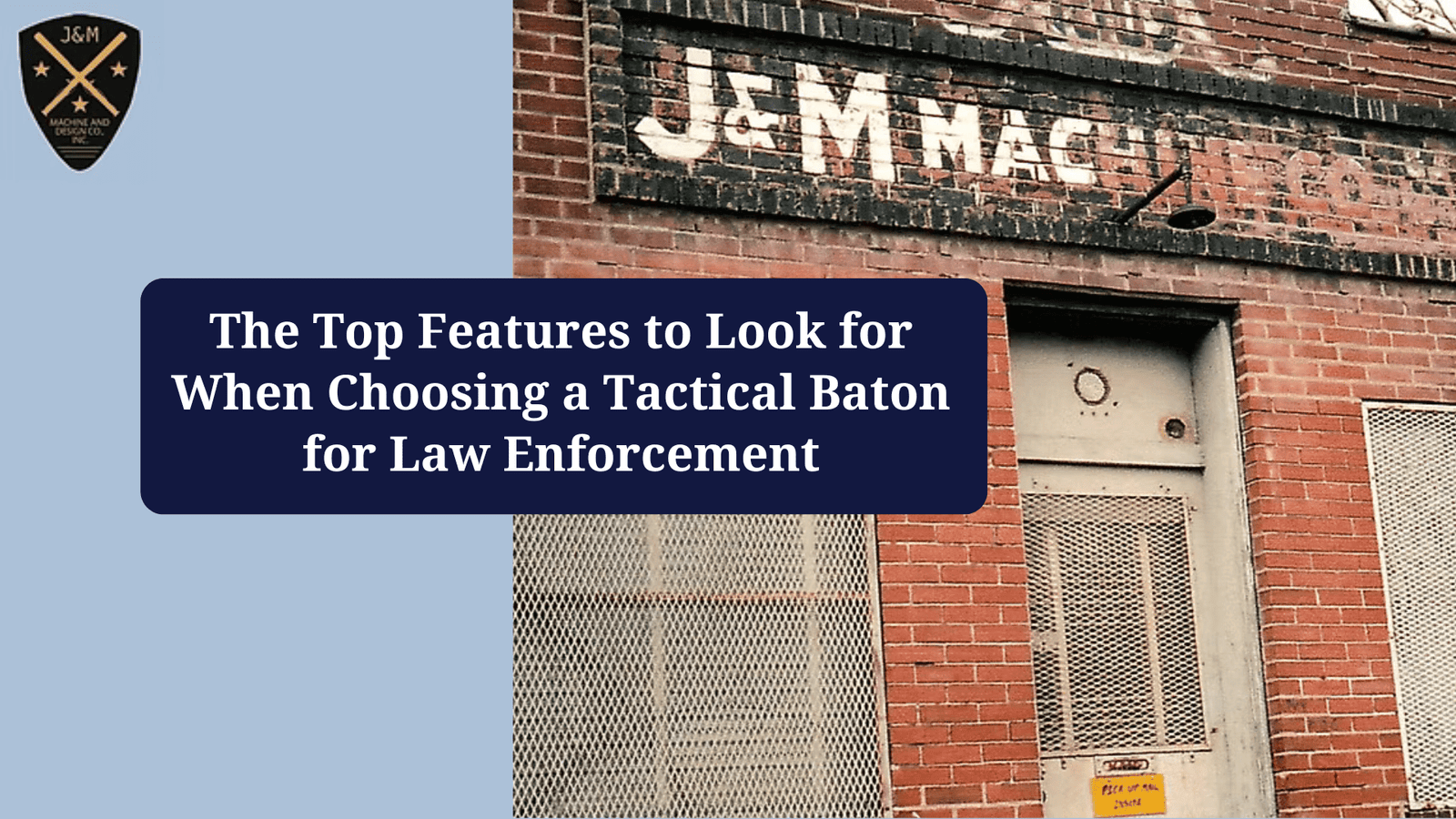The Top Features to Look for When Choosing a Tactical Baton for Law Enforcement

Tactical batons, commonly known as nightsticks or police batons, are essential tools for law enforcement officers. Whether used for self-defense, crowd control, or subduing suspects, a baton needs to be both reliable and effective in high-pressure situations. With so many different options on the market, choosing the right tactical baton can be daunting. It’s important to consider various design features that ensure comfort, control, and durability, all of which play a significant role in an officer's ability to perform their duties effectively.
In this guest post, we’ll explore the top features to look for when selecting a tactical baton for law enforcement, helping you make an informed decision for your department or personal use.
1. Material and Durability
The first and most important feature to consider when choosing a tactical baton is the material. The quality and strength of the material used in manufacturing the baton directly impacts its performance, durability, and overall reliability.
-
Wooden Batons: Traditional wooden nightsticks, often made from woods like Hickory, Bacote, or Granadilla, are highly valued for their natural shock absorption, strength, and classic design. Wood offers a great balance of durability and comfort, making it ideal for extended use. The advantage of wooden batons is that they absorb the shock from strikes, reducing strain on the officer’s wrist and hand.
-
Aluminum and Steel Batons: While metal batons (such as those made of aluminum or steel) tend to be heavier and more rigid, they offer superior strength and impact resistance. These batons are highly effective in situations where more force is required. However, they can be prone to causing more strain on the officer’s hand and wrist after prolonged use.
-
Fiberglass Batons: Fiberglass batons are known for being lightweight, strong, and impact-resistant. They are typically less expensive than metal or wooden batons but still provide a solid, durable tool. However, they often lack the shock-absorbing properties of wood, which could be a disadvantage during extended use.
When selecting a baton, consider how often it will be used and in what kind of environments. For instance, if your officers face long shifts with extended crowd control duties, a wooden baton or a fiberglass baton may be better suited due to their lighter weight and shock absorption.
2. Ergonomic Handle and Grip
Comfort is a critical factor in the overall effectiveness of a tactical baton. A poorly designed handle or grip can cause hand fatigue, leading to decreased performance, or worse, an accidental drop of the baton in a critical situation.
Look for the following ergonomic features in a baton:
-
Ergonomic Shape: A baton with a handle that is designed to fit naturally in the hand will ensure a more secure and comfortable grip, reducing the risk of hand fatigue during prolonged use.
-
Textured Grip: A textured or rubberized grip provides better traction, which is particularly helpful in high-stress situations or when officers’ hands are sweaty or wet. Textured grips prevent slipping, ensuring the officer maintains a secure hold on the baton.
-
Tapered Handles: Many tactical batons feature a tapered handle, which fits comfortably into the hand and provides better control while in use. A handle that tapers to a narrower base will prevent the baton from slipping, allowing for greater control during tactical maneuvers.
-
Contoured or Carved Handles: Some high-quality tactical batons feature handles that are carved or contoured to fit the officer’s hand shape. This helps in reducing the pressure points that can cause discomfort during extended use and gives a more customized feel.
3. Weight and Balance
The weight and balance of a tactical baton directly affect how well it can be maneuvered. A baton that is too light might lack the striking power needed for self-defense or suspect subduing, while one that is too heavy could be cumbersome and slow to use.
-
Weight Considerations: A baton’s weight should allow for quick movements without being too heavy. For extended use in crowd control or patrolling, a lightweight baton is preferable. On the other hand, for self-defense or tactical use, a baton that offers slightly more weight may provide greater striking force.
-
Balance: The balance of the baton determines how easy it is to control. A well-balanced baton should allow the officer to swing it quickly while maintaining accuracy and control. It should feel comfortable in the officer’s hand, with an even weight distribution that prevents fatigue.
For crowd control and patrol situations, an ergonomically balanced baton that’s lightweight will likely be preferred. However, in high-impact self-defense situations, a slightly heavier baton made from metal or premium wood may be beneficial due to its additional striking power.
4. Length and Reach
The length of a tactical baton is another critical feature to consider. The ideal length will depend on the officer’s needs and the situations they face. Tactical batons typically range in length from 16 inches to 26 inches, with some models offering adjustable lengths.
-
Shorter Batons (16–18 inches): These batons are generally more maneuverable and easier to carry, making them ideal for self-defense or situations where close-quarter combat might occur. They are also easier to conceal, which may be a preference for undercover officers or those in civilian clothing.
-
Longer Batons (20–26 inches): A longer baton provides greater reach and allows for more powerful strikes, which is beneficial in situations requiring distance or crowd control. Officers who face larger crowds or need to keep a safer distance from a suspect may prefer a longer baton.
Look for a baton that suits your tactical needs—whether you require maneuverability, reach, or a balance between the two.
5. Durability and Longevity
Law enforcement officers depend on their batons to perform consistently under stressful conditions. A tactical baton should not only be strong but also durable enough to withstand the demands of daily use, including exposure to the elements, moisture, and impact.
-
Weather Resistance: Batons made from premium wood or fiberglass typically offer resistance to moisture, making them ideal for use in rainy or humid conditions. Aluminum and steel batons are also corrosion-resistant but may be prone to temperature fluctuations that can cause discomfort.
-
Impact Resistance: When choosing a baton, look for materials known for their impact resistance. Hardwood batons, like Hickory or Granadilla, are highly resilient to wear and tear. Metal batons, like those made of steel, are incredibly durable and able to withstand significant force.
-
Maintenance Needs: Wooden batons, while durable, require occasional maintenance to prevent splitting or cracking. On the other hand, metal and fiberglass batons generally require less maintenance and are easier to keep in good condition.
6. Expandable and Collapsible Batons
For officers or security personnel who require a baton that is easy to carry and deploy quickly, an expandable or collapsible baton is an excellent choice. These batons are designed to be compact when not in use and can be rapidly extended with a flick of the wrist, making them highly convenient for on-the-go use.
-
Quick Deployment: Expandable batons provide the benefit of quick access and are ideal for officers who need a baton in a hurry.
-
Compact for Carry: These batons are ideal for officers who need to carry them while on patrol, as they collapse into a smaller, more manageable size for easy storage and concealment.
7. Price and Value
Finally, when choosing a tactical baton, cost is always a factor. While some batons may come at a lower price, it’s important to remember that quality should never be compromised for cost. A poorly made baton can fail during critical moments, which can result in injury or failure to perform effectively.
Investing in a high-quality baton made from premium materials like Granadilla, Bacote, or Hickory may come with a higher upfront cost, but it is a valuable long-term investment in terms of durability, comfort, and reliability.
Conclusion
Choosing the right tactical baton for law enforcement is crucial for ensuring that officers are prepared, safe, and effective during operations. Whether it’s for self-defense, crowd control, or tactical use, the right features—including material, grip, weight, length, and durability—make all the difference.
Wooden nightsticks, especially those made from premium materials like Granadilla, Bacote, and Hickory, provide a perfect combination of strength, shock absorption, and comfort, which are essential for effective performance. Collapsible batons and ergonomic designs offer convenience and maneuverability, while expandable options allow for quick deployment.
By selecting a baton that fits your needs, you ensure that you are equipped with a tool that provides reliability, durability, and control in any situation. A good tactical baton is an investment in the safety and performance of law enforcement professionals, security officers, and anyone who needs a dependable self-defense tool.




